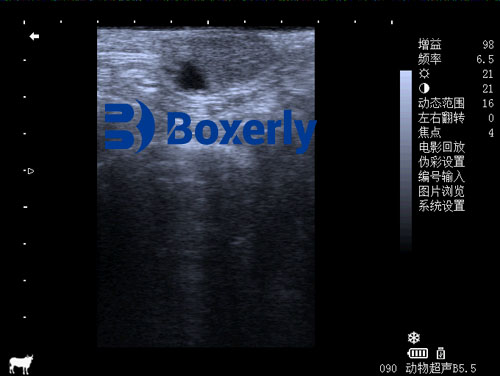Mastitis is one of the most frustrating, costly, and persistent challenges for dairy farmers around the world. On large-scale farms, where hundreds or even thousands of cows are milked daily, early detection and effective monitoring of mastitis can make the difference between profit and loss. That’s where portable ultrasound has stepped in as a game-changer.

Unlike traditional diagnostic methods like manual palpation or relying on milk conductivity, portable ultrasound offers real-time insight into udder health. More importantly, it gives vets and farm managers a non-invasive, fast, and repeatable way to track changes in mastitis severity across large herds.
Mastitis: Still the Dairy Industry’s Big Problem
Every dairy farmer knows how easily mastitis can sneak up. One day, a cow’s milk looks normal. The next, she’s down in production, the somatic cell count spikes, and the milk turns abnormal. While subclinical mastitis often goes unnoticed, it causes long-term damage to the udder and leads to declining milk yield, increased culling, and antibiotic use.
What makes mastitis such a difficult condition is its variability. Environmental bacteria, contagious pathogens, cow immunity, and even milking machine hygiene play a role. And on large farms, it’s easy for things to slip through the cracks. This is why foreign farms, particularly in the U.S., Canada, the Netherlands, and New Zealand, have increasingly turned to portable ultrasound to monitor udder health as part of their standard operating procedures.
How Portable Ultrasound Helps
Portable ultrasound—lightweight, battery-powered, and rugged—is proving especially useful in fast-paced, high-density operations. With a veterinary-specific probe, farm staff or vets can quickly scan the udder, especially the mammary glands and cisterns, for signs of inflammation, fibrosis, abscesses, and tissue asymmetry.
What makes this method stand out is its ability to detect tissue changes before clinical signs appear. That means farmers can catch mastitis earlier—sometimes days earlier—before milk changes or visible swelling. This early detection leads to more targeted treatments and prevents the spread of contagious mastitis within the milking herd.
Ultrasound is also excellent for monitoring treatment response. In many herds, especially where blanket antibiotic use is being replaced by selective therapy, being able to track the healing of inflamed tissue is a major advantage. On Dutch farms, for example, ultrasound is used every 2–3 days post-treatment to determine whether fibrosis is forming or if the udder is returning to normal function.
What We See on the Screen
On a portable B-mode ultrasound, healthy mammary tissue appears uniform and structured. When mastitis sets in, the first visual cue is a loss of that uniformity—heterogeneous echotexture, fluid pockets, or visible abscesses may appear. With chronic mastitis, the ducts may show echogenic strands or thickened walls due to fibrosis.
In the hands of trained farm staff or veterinarians, this image becomes a decision-making tool. One Canadian dairy vet explained in a recent workshop:
“We no longer wait for SCC [somatic cell count] results to act. If the scan shows signs of abscess or chronic changes, we adjust the treatment protocol right away. ในบางกรณี, we avoid treatment entirely and move toward culling, especially if the gland is clearly fibrotic.”
A Tool for More Than Just Diagnosis
One of the best things about portable ultrasound is that it can track progress. Farms using systems like BXL-V50, which combine high-resolution imaging with long battery life and easy-to-clean designs, are now using ultrasound in multiple stages:
-
Screening during dry-off: Catching subclinical mastitis before the cow enters the dry period
-
Monitoring fresh cows: Within the first week post-calving to detect peripartum mastitis
-
Follow-up after treatment: Visualizing whether inflammation is resolving or worsening
-
Pre-culling assessment: Scanning chronic cases to support the decision to remove the animal
This approach has been implemented widely on larger dairy farms in Germany and the Midwest U.S., where herd size makes one-on-one physical inspections difficult. One vet in Iowa reported a 23% drop in antibiotic usage within the first year of integrating routine ultrasound checks.

Not Just for Vets Anymore
Thanks to improvements in portability and user interfaces, more farm workers—not just veterinarians—are learning how to use ultrasound. Many large farms now train herd health managers to perform basic udder scans.
It’s no longer a highly specialized skill. On some New Zealand dairy operations, ultrasound is used right in the milking parlor during routine SCC testing. The scan takes less than two minutes per cow and gives instant feedback that complements lab data.
In the U.K., where antibiotic reduction programs are government-mandated, ultrasound is part of the national quality assurance framework. Farms showing ultrasound-based mastitis tracking often get compliance bonuses and reduced insurance premiums.
Ultrasound vs. Other Monitoring Methods
Let’s compare it to the old ways:
| Method | Strengths | Weaknesses |
|---|---|---|
| SCC (Somatic Cell Count) | Objective, widely used | Delayed results, can’t localize issue |
| Palpation | Quick, no tools needed | Inaccurate in early stages |
| Milk conductivity | Real-time | High false-positive rate |
| Ultrasound | Real-time, anatomical imaging | Requires minimal training & equipment |
Practical Benefits for Large Farms
-
Speed: With a skilled user, scanning 50 cows can be done in under an hour.
-
Accuracy: Differentiates between acute inflammation and chronic fibrosis.
-
Non-invasive: No discomfort to the cow, no milk withdrawal time.
-
Decision support: Backed by real-time visual data, not guesswork.
Portable ultrasound isn’t replacing other diagnostic tools—it’s adding another layer of accuracy and responsiveness.
Economic and Welfare Payoff
Every cow lost to mastitis costs money: lost milk, treatment costs, and possible early culling. When mastitis turns chronic, the gland may never fully recover. By using ultrasound early, some farms have reported:
-
A 15–30% reduction in clinical mastitis incidence
-
Shorter treatment duration
-
Better decisions about which cows to treat vs. cull
-
Higher milk yield per cow over the lactation period
Cow welfare also improves. By reducing pain, overmedication, and unnecessary handling, herds become more stable and productive.
Looking Ahead: More Farms Will Adopt This
As equipment becomes more affordable and training spreads, portable ultrasound will likely become a standard tool on large dairy operations worldwide. Some predict it may become as routine as checking body temperature.
With advances in AI-assisted imaging, future ultrasounds may offer automatic mastitis scoring, making it even easier for non-veterinarians to make informed decisions in real time.
But even with today’s tech, the shift is already happening. Farmers want practical tools that work. Ultrasound checks all the boxes: quick, accurate, and cost-effective.